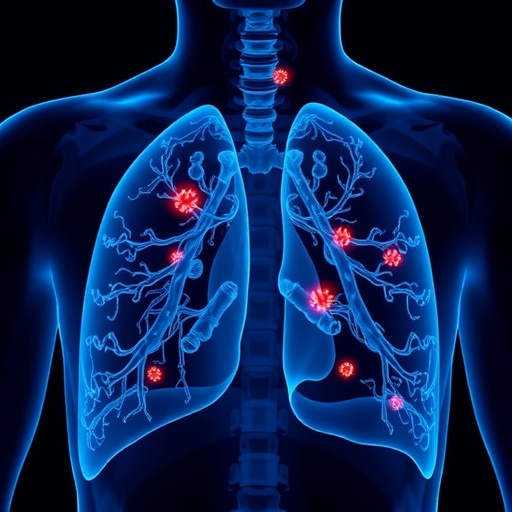In a groundbreaking advancement in the field of oncology and immunotherapy, researchers have unveiled crucial insights into the immune dynamics within tumors and their correlation with long-term clinical outcomes in patients with stage IIIA non-small cell lung cancer (NSCLC) undergoing neoadjuvant chemoimmunotherapy. This extensive study sheds light on the complex interplay between cancer cells and the immune system, offering new hope for tailored treatment strategies and improved survival rates in one of the most challenging forms of lung cancer.
The research, conducted by Schmid, Sobottka, Manzo, and their team, is a detailed exploration of the immune microenvironment within NSCLC tumors treated before surgery with a combination of chemotherapy and immunotherapy agents. Neoadjuvant treatments are designed to reduce tumor size and eliminate micrometastases, thereby improving the success of subsequent surgical resection. However, the variability in patient responses has sparked intense scientific inquiry into the underlying mechanisms governing treatment efficacy.
At the heart of this study lies the observation of immune cellular composition and functional states within the tumor milieu. The investigators meticulously analyzed longitudinal samples from patients, mapping the temporal evolution of immune cell populations during the course of therapy. Their findings indicate that dynamic shifts in immune infiltrates, particularly T cell subsets, are predictive of therapeutic outcomes and can inform prognosis.
Specifically, the study highlights that the presence and activation status of cytotoxic CD8+ T cells, often regarded as the immune system’s frontline soldiers against cancer, correlate strongly with improved pathological responses and longer progression-free survival. This suggests that an effective anti-tumor immune response, potentiated by neoadjuvant immunotherapy, plays a pivotal role in controlling disease progression.
Parallel to T cell dynamics, regulatory T cells (Tregs), known for their immunosuppressive functions, displayed complex temporal patterns. An initial increase followed by a subsequent decrease in Tregs was associated with better clinical outcomes, implying that modulating immune suppression within the tumor microenvironment is critical for sustaining effective anti-cancer immunity.
The study also thoroughly evaluated the role of myeloid cells, including tumor-associated macrophages and dendritic cells, which are instrumental in shaping immune responses. Durable clinical benefit was linked with a shift towards a pro-inflammatory macrophage phenotype and enhanced antigen presentation capabilities of dendritic cells, underscoring the multifaceted nature of immune orchestration in response to chemoimmunotherapy.
Employing sophisticated multi-omics technologies and spatial profiling, the researchers captured not only the cellular composition but also the spatial distribution and interaction networks of immune cells within the tumor. Their data revealed that proximity of effector T cells to tumor cells and the formation of immune cell niches contribute substantially to the eradication of malignant cells.
Importantly, this study bridges the gap between immune dynamics at a molecular and cellular level and clinically meaningful endpoints such as overall survival and recurrence rates. Patients exhibiting robust immune activation signatures post-treatment enjoyed prolonged disease-free intervals, affirming the prognostic value of immune profiling in this context.
The durability of response observed in some patients also sheds light on mechanisms of resistance and relapse. Persistent immunosuppressive features and exhausted T cell phenotypes emerged as hallmarks of poor responders, providing valuable biomarkers for patient stratification and potential targets for therapeutic intervention.
Beyond its clinical implications, this research advances the conceptual framework of tumor immunology by emphasizing the temporal dimension of immune responses. Traditional snapshots of the tumor immune landscape are insufficient; instead, tracing the evolution of immune cells throughout treatment uncovers critical windows for therapeutic modulation.
As the oncology community seeks to refine neoadjuvant strategies, this study’s insights pave the way for personalized immunotherapy regimens. By identifying patients who are likely to benefit from specific immunomodulatory approaches, clinicians can optimize treatment plans, minimize toxicity, and improve quality of life.
The integration of chemo- and immunotherapeutic modalities showcases the synergistic potential of combining cytotoxic agents with immune checkpoint inhibitors. Chemotherapy-induced immunogenic cell death primes the immune system, while checkpoint blockade unleashes suppressed T cells, culminating in enhanced tumor control.
Furthermore, the work underscores the necessity of incorporating immune monitoring into clinical trials. Immune biomarkers should be considered primary endpoints alongside traditional measures, enabling a more nuanced understanding of treatment responses.
Looking ahead, the findings stimulate excitement for the development of next-generation therapies targeting the regulatory nodes within the tumor immune microenvironment. Strategies such as Treg depletion, macrophage reprogramming, and T cell reinvigoration hold promise in overcoming resistance and sustaining long-term remission.
The multi-disciplinary nature of this research, blending immunology, oncology, genomics, and computational biology, exemplifies the power of integrative approaches in unraveling cancer complexity. Collaboration between basic scientists, clinicians, and bioinformaticians was essential in translating cellular observations into actionable clinical knowledge.
In summary, the study by Schmid and colleagues marks a significant milestone in understanding the dynamic immune landscape of NSCLC treated with neoadjuvant chemoimmunotherapy. Their comprehensive analysis illuminates the pathways through which the immune system mediates therapeutic success and underscores the potential of harnessing immune dynamics to revolutionize cancer treatment.
This work not only enhances our comprehension of tumor-host interactions but also offers a beacon of hope for patients battling stage IIIA NSCLC. With continued research inspired by these findings, the future of personalized immuno-oncology looks increasingly promising, steering the field towards more durable and effective cancer therapies.
Subject of Research: Tumor immune dynamics and their impact on long-term clinical outcomes in stage IIIA non-small cell lung cancer patients treated with neoadjuvant chemoimmunotherapy.
Article Title: Tumor immune dynamics and long-term clinical outcome of stage IIIA NSCLC patients treated with neoadjuvant chemoimmunotherapy.
Article References:
Schmid, D., Sobottka, B., Manzo, M. et al. Tumor immune dynamics and long-term clinical outcome of stage IIIA NSCLC patients treated with neoadjuvant chemoimmunotherapy. Nat Commun 16, 8673 (2025). https://doi.org/10.1038/s41467-025-63696-5
Image Credits: AI Generated




